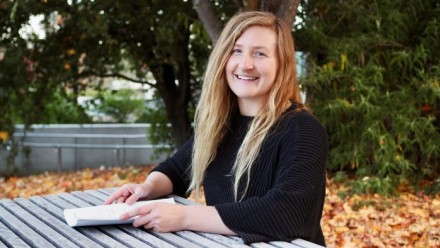Modelling climate variability – ICEDS Member Profile, Dr Georgy Falster
The climate models that Dr Georgy Falster uses are so sophisticated that running a single simulation takes three months on a supercomputer. With her colleagues, she recently used eleven of these simulations that look back in time more than a thousand years to estimate Australia’s long-term climate variability. The team found that Australia has likely experienced naturally occurring “mega droughts” that can last decades, something that is all the more worrying as both global and Australian rainfall records show climate change related increases in drought length and severity.
Georgy came to work at the ANU in the Australian Research Council Centre of Excellence for Climate Extremes on the drought research program, but her interest in droughts goes back much further. Growing up as a millennial in South Australia, the Millennium Drought was a major event in her formative years. “The Murray River basically stopped flowing at the South Australian border, the Murray mouth almost completely closed,” she recounts. She recalls television ads encouraging people to save water and turn off taps. In recent years she has had a global focus, working as a Postdoctoral Research Associate at Washington University in St. Louis with research focused on the tropical Pacific. Now focusing as well on Australia’s climate, she says “it's been really interesting to come back to something I’m very innately familiar with and has direct relevance for my friends and family in Australia.”
Her most recent work with computer models represents a departure from her earlier research. In the past, she has used empirical data, meaning data that comes from observations. These observations can come from things like rain gauges or paleoclimate proxy data, which is data taken from proxies such as tree rings. Both sources have limitations, she explains: “Observations – we only have direct observations for at most a hundred years or so; and paleoclimate proxy data are very sparsely distributed across Australia and don’t directly record rainfall totals.” This is why computer models are so valuable. Using our knowledge of weather systems, these models use equations to represent the climate system. The models used already existed, representing a huge effort from a global community of climate researchers. They have complete spatial coverage, but also across time. Georgy’s research uses models that have been run backwards in time, to estimate Australia’s climate variability over the past thousand years or so.
Georgy’s recent findings, while alarming, are important as they give us information we need to prepare for longer and more severe future droughts. She explains that, while Australia has the potential for naturally occurring megadroughts,
The reality is that if droughts occur today, they’re occurring against the backdrop of hotter temperatures that are a result of human caused climate change. To reduce the severity and impact of future droughts, the one thing we can do, of course, is rapidly reduce greenhouse gas emissions.
Following on from their most recent findings, the research team will now try to understand this local climate variability in the broader global context. They will look at known weather drivers such as the El Niño Southern Oscillation, the Indian Ocean Dipole and Southern Annular Mode as well as other “external forcings” such as volcanic eruptions to see if these have any effect on the occurrence of mega droughts, or whether they are purely random.
Dr Georgy Falster is a member of the ANU Institute for Climate, Energy & Disaster Solutions (ICEDS), which connects people with climate, energy and disaster-risk research from The Australian National University. ICEDS Membership is free and open to academics (including Visiting Fellows), PhD/HDR students, and professional staff who are involved in climate change, energy transition, or disaster risk science related research and education at ANU. Click here to find out more and join the Institute.











